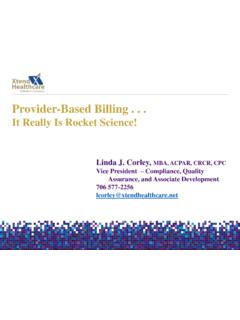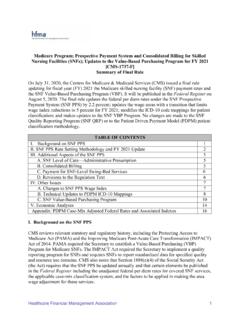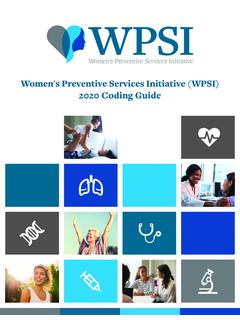Transcription of Medical Coding Best Practices for Emergency Departments
1 | | 1 | Medical Coding Best Practices for Emergency Departments Medical Coding Best Practices for Emergency Departments 1. 2018 accesshealthcare | All Rights Reserved | | 2 | Medical Coding Best Practices for Emergency Departments Summary Delivering quality care, while ensuring effective clinical documentation and compliant Medical Coding has always been a challenge for healthcare providers. This gets even trickier in Emergency Departments , which are fast-paced environments spread across multiple specialties. Therefore, Emergency Departments present unique Medical Coding and billing challenges. Alongside knowledgeable clinical staff, specialized Medical coders and billers with the requisite experience and strong analytical skills are required to obtain necessary reimbursements.
2 In this paper, we share our perspectives on the unique Medical Coding and billing challenges presented by Emergency Departments and the best Practices to ensure optimal reimbursements. 2. 2018 accesshealthcare | All Rights Reserved | | 3 | Medical Coding Best Practices for Emergency Departments Three challenges impacting the quality of care and claim reimbursements in ED. Factors influencing Quality Factors influencing claim Why challenging? of care reimbursement Fast Paced Environment. Revenue Leakage. The nature Unlike Outpatient and Inpatient visits The shorter execution time means that of Emergency that provide adequate clinical decision- the documentation time available to Departments : making time, the fast-paced ED providers is limited as well.
3 Providers Unscheduled and environment demands instant cognitive often miss capturing all Medical services an Emergency clinical decisions and shorter execution rendered along with medically necessary time depending on the criticality of the diagnosis, leading to high instances of patient's condition and by definition, an discharges not fully billed (DNFB cases). Emergency itself. and denied claims. Timely Coordination of services. Differentiating Physician vs Facility The ED team involves a wide range of services. healthcare experts from Emergency Detailed information on coordination Medical Technicians (EMT) initiating of care provided by ED physicians vs Coordination Emergency clinical support from the the nursing and ancillary staff is pivotal with multiple moment the patient is boarded into for the coders to distinguish physician/.
4 Faculty staffs the ambulance, and then taken over professional services vs facility services consecutively by multiple skilled faculty and provide credit on Coding accordingly. members that include ED Physicians, Specialists, Residents, Nurse Practitioners (NPs), Registered Nurses (RNs), Physician Assistants (PAs), Patient Care Technicians (PCTs) etc. Longer hours of stay at ED could be Distinguishing Emergency deparment tricky. services vs observation care. EDs think in terms of minutes and hours, While Coding for instances of longer stays, not hospital days. Shaving precious especially those spanning beyond a day, minutes off a patient encounter can coders need to be diligent in reviewing Length of stay vastly improve patient experiences.
5 The the clinical documentation to correctly most common reasons for a longer ED classify ED services vs observation care. In stay could be the Medical condition most cases, there is a thin line and right demanding a longer observation or interpretation of the documentation is unavailability of beds when the decision is key to appropriately Coding for these made to admit to inpatient environment. services. 3. 2018 accesshealthcare | All Rights Reserved | | 4 | Medical Coding Best Practices for Emergency Departments Medical Coding Best Practices for Emergency Departments Improve first pass ratio of ED Claims and improve reimbursements while being compliant In this section, we provide a few best Practices that aid compliant Coding and improve first pass ratio of ED claims.
6 Understanding the claim journey, documentation requirements, and Coding rules is the triad of delivering compliant Coding services. 1 Recognize that Emergency Departments are at a Critical Intersect of Care The Emergency Department lies at the intersect of outpatient and inpatient services. The claim cycle, there- fore, diverges into two paths: Professional Coding and billing through CMS 1500 representing physician services rendered. Facility Coding and billing through UB 04 representing facility services rendered. 2 Understand Key Documentation Attributes that Influence ED level Irrespective of the type of care (Professional or Facility), it is imperative that the physicians, nursing and support staff capture complete details for all Medical services rendered.
7 Here are some pointers to improve Professional and Facility ED documentation: a) Determining Professional ED Level Professional ED level is determined by the extent of clinically significant documentation furnished by the ED. physicians under history, examination, and Medical decision making relevant to the patient's current condition as evidenced during the ED visit. We share a few best Practices below: Enable clinicians to concurrently deliver care and document the charts by using well-designed electronic ED charting tools. Not only will this reduce revenue leakage on account of missed procedures, but also improve the effectiveness of clinical decision-making, ensure safe hand-off, and reduce unnecessary admissions.
8 Potential to utilize Scribes. With Emergency physicians working under constant pressure to deliver high-quality care, utilizing Medical scribes could be a potential solution to improve clinical documentation and Coding effectiveness. Scribes help chart Physician-patient encounters real time on electronic health record (EHR) systems. When EHRs are documented using scribed services, it should indicate who performed the service and who recorded the service. The scribed notes should include the name, title, and signature of the scribe followed by the name of the practitioner providing and attesting the service. 4. 2018 accesshealthcare | All Rights Reserved | | 5 | Medical Coding Best Practices for Emergency Departments b) Determining Facility ED Level The facility ED level, on the other hand, is determined by the extent of services rendered by nursing and ancillary staff and not by ED physicians; we share a few best Practices below: ACEP (American College of Emergency Physicians) recommends a Coding model that references possible Interventions/procedure examples and complexity of discharge instructions that serve as a proxy referencing the typical intensity of facility services provided for patients requiring them.
9 Based on the patient's symptoms, procedures may vary from simple interventions like Prescription refill, suture removal or wound recheck that usually qualify for 99281/Level 1 to more complex interventions like frequent monitoring of vitals, Prep for procedures like CT, MRI, central line insertions etc. that qualify for 99285, taking into consideration the entire documentation. 3 Educate Physicians on Documentation Requirements Relevant clinical information is vital Educating ED clinicians on clinically significant and relevant documentation is key to achieving compliant Coding and optimizing end revenue/reimbursement. Most practice management systems today have inbuilt functionality that includes pre-defined Electronic Medical Record (EMR)/Electronic Health Record (EHR) templates to aid in documentation of areas that require focus.
10 While it is the provider's choice to choose free text vs. EMR templates, EMR templates definitely aid in ensuring better and complete documentation using the cues available. Adoption of these templates is one of the key physician education areas. Cloning is another challenge with EMR where providers use the same document of Physical Exam that is comprehensive but might not be pertinent to the chief complaint(s) or reason for the visit resulting in Medical necessity evidence becoming questionable. ED providers should ensure that the documentation is pertinent to the visit and often providers need to be sensitized to the need for effective documentation. Coding and Clinical Documentation Improvement experts can help institutionalize comprehensive documentation Practices , through iterative reviews and education of providers.






